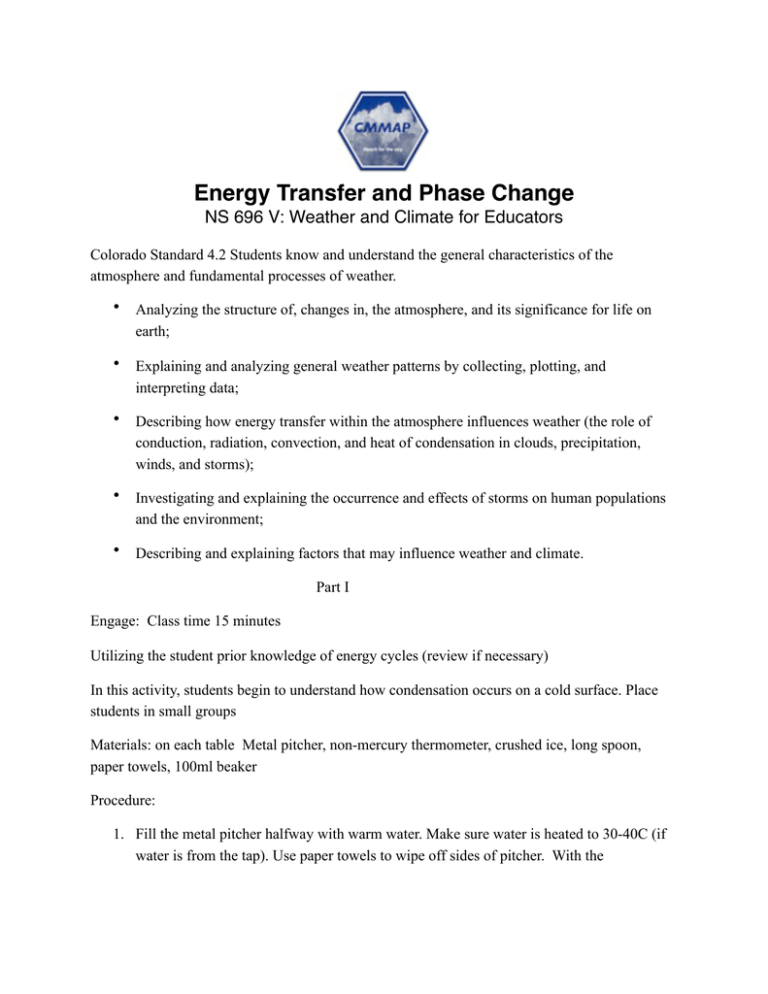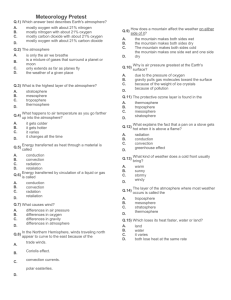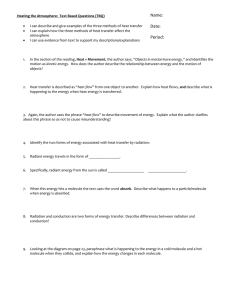Energy Transfer and Phase Change
advertisement

Energy Transfer and Phase Change NS 696 V: Weather and Climate for Educators Colorado Standard 4.2 Students know and understand the general characteristics of the atmosphere and fundamental processes of weather. • Analyzing the structure of, changes in, the atmosphere, and its significance for life on earth; • Explaining and analyzing general weather patterns by collecting, plotting, and interpreting data; • Describing how energy transfer within the atmosphere influences weather (the role of conduction, radiation, convection, and heat of condensation in clouds, precipitation, winds, and storms); • Investigating and explaining the occurrence and effects of storms on human populations and the environment; • Describing and explaining factors that may influence weather and climate. Part I Engage: Class time 15 minutes Utilizing the student prior knowledge of energy cycles (review if necessary) In this activity, students begin to understand how condensation occurs on a cold surface. Place students in small groups Materials: on each table Metal pitcher, non-mercury thermometer, crushed ice, long spoon, paper towels, 100ml beaker Procedure: 1. Fill the metal pitcher halfway with warm water. Make sure water is heated to 30-40C (if water is from the tap). Use paper towels to wipe off sides of pitcher. With the thermometer measure the temperature of the air in the classroom and the temperature of the water in the pitcher. Record these in your journal. 2. Fill the 100ml beaker with crushed ice, then pour the ice into the pitcher and stir the ice with the long spoon. 3. Repeat step 2 until the water begins to appear on the outside of the pitcher. When this occurs, measure and record the temperature of the water in the pitcher. Explore/Analyze Students will compare the temperature at which drops of water appeared on the outside of the pitcher to the temperature of the air in the classroom. Formulate a hypothesis of how you think the water appeared what kind of energy made this happen? Part II Explain: Using this introduction activity we know can lead the students into the part of describing the processes by which energy heats the troposphere. • Objectives: what happens to the energy Earth receives from the sun? • How is energy transferred within the troposphere? Instruct: There are three main forms of transfer of energy that can heat our surface (define them) radiation, convection and conduction. Energy is transferred within the troposphere by Solar (sun) radiation which heats Earth’s surface, which in turn transfers energy to the troposphere (upward). Energy is released by Earth’s surface in the form of infrared radiation. (explain the electromagnetic spectrum briefly) Atmospheric gases such as water vapor, carbon dioxide, and methane absorb infrared radiation. These greenhouse gases also reradiate some of that energy back to earth’s surface. This transfer of energy by radiation is very efficient and is the primary mechanism by which the troposphere is heated. The air in direct contact with Earth’s surface is heated by conduction. Air is not a good conductor of heat, so conduction is the least significant way heat is transferred. Warm air near the surface rises and expands and cooler, denser air sinks, forming convection currents that move heat through the troposphere. Because in convection some heat energy is converted to kinetic energy, convection is a less efficient way of transferring heat. Convection cells in the atmosphere exist simultaneously on global, regional, and local scales. Global convection cells produce high pressure in the region of 30N. Within that region, different surfaces have different heat capacities which set up temperature and pressure differences and smaller cells are formed. These small cells can result into local winds and other weather conditions. During this lecture you can demonstrate the three methods by using simple tools of a heat lamp and having students come up to feel the heat; rubbing their hands together to feel the transfer of energy; having hot water in a beaker and with food coloring to have a convection cell appear, and different slides of the electromagnetic spectrum. Part III Extend: Have students research the specific wavelengths of infrared radiation that are absorbed by each of the major gases in the atmosphere. Part IV Evaluate: Have students construct a concept map connecting the main ideas of energy flow through the atmosphere and extend this map into how this energy affects the differences in weather throughout a typical day (the production of storms). This can lead you into the next lesson on cloud formations, weather patterns, fronts etc. Lesson generated by Gina Festigitano





![Applied Heat Transfer [Opens in New Window]](http://s3.studylib.net/store/data/008526779_1-b12564ed87263f3384d65f395321d919-300x300.png)
